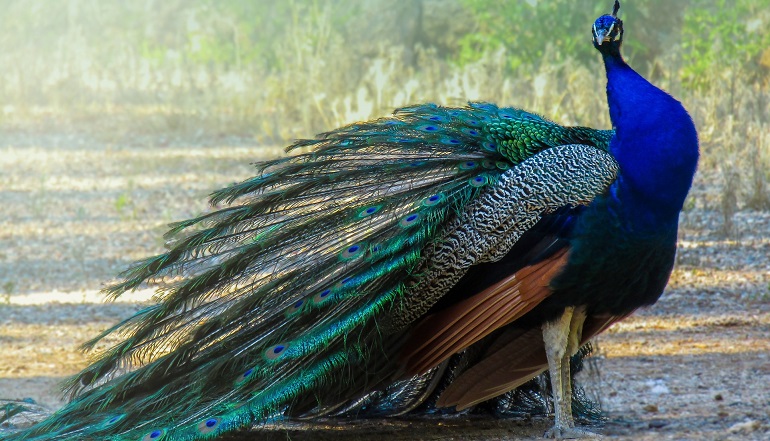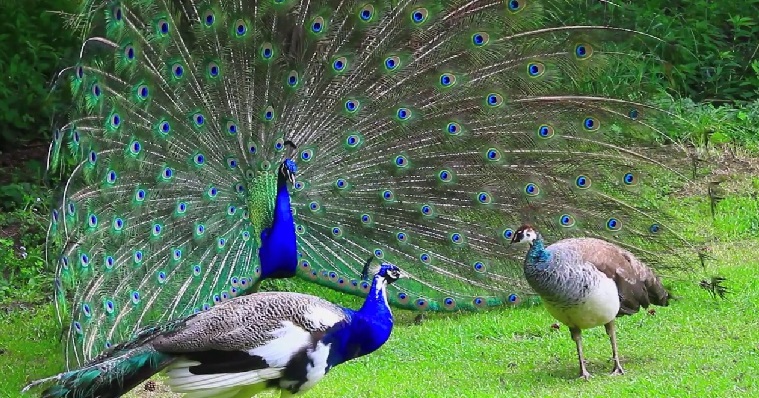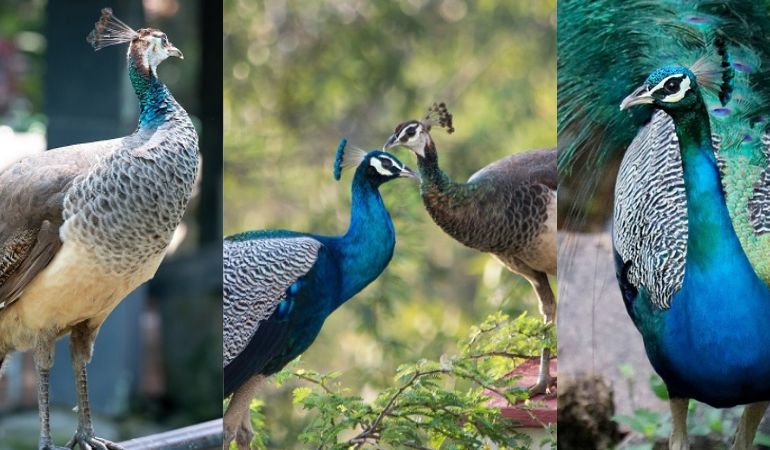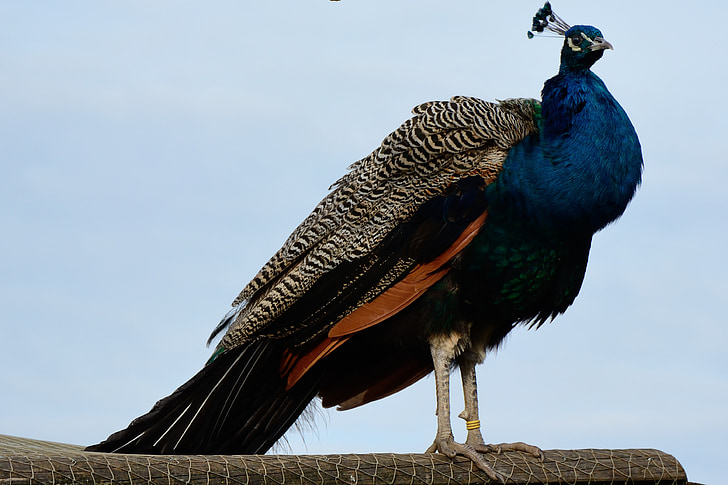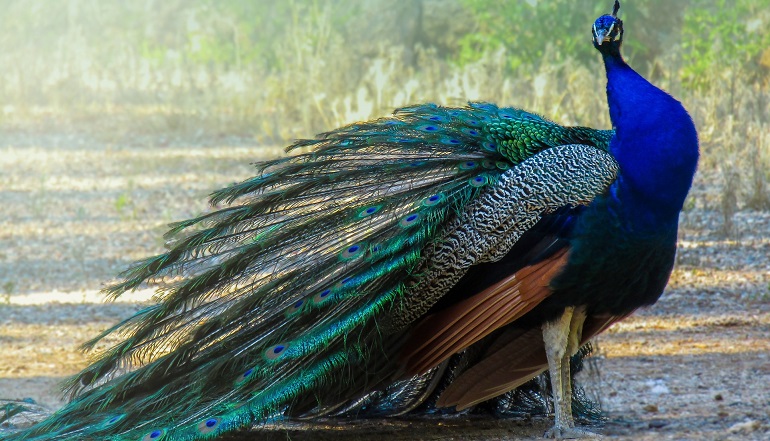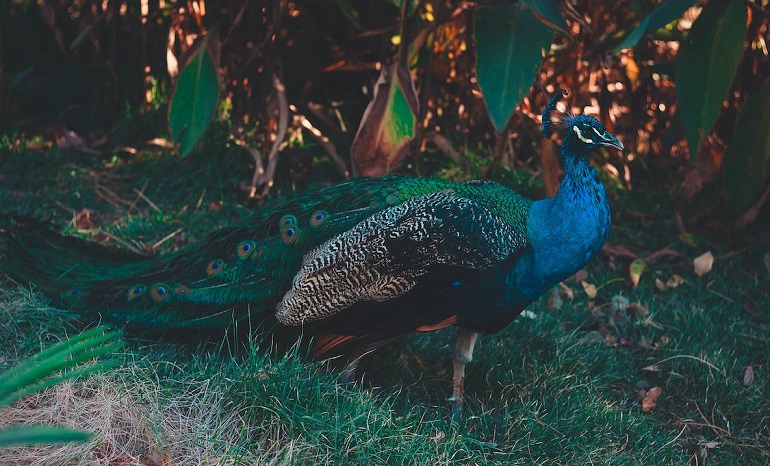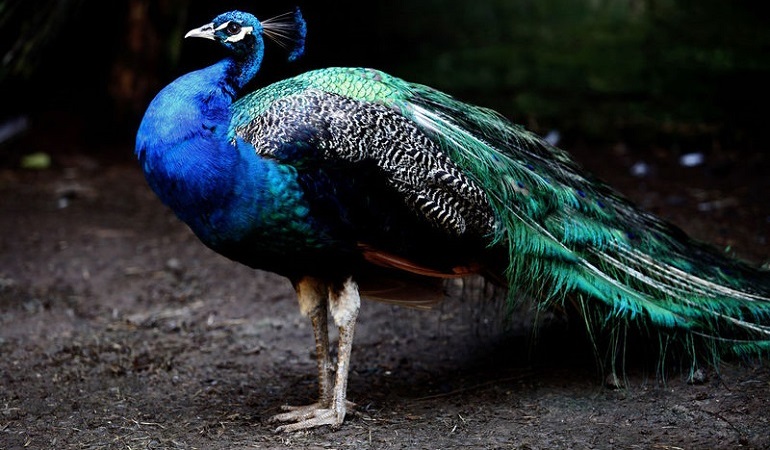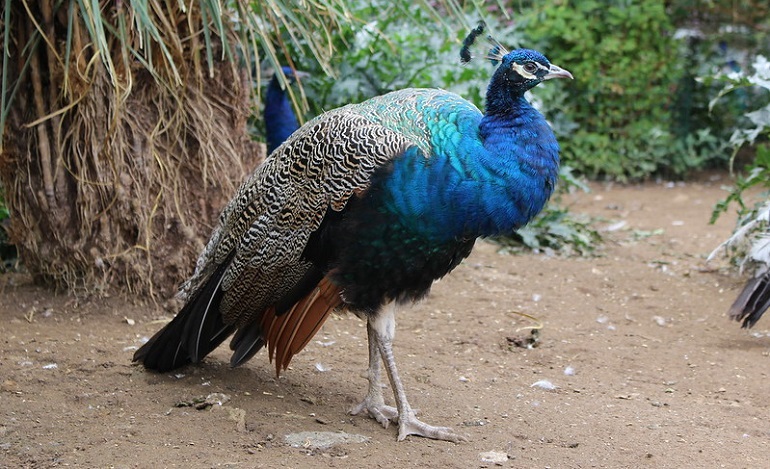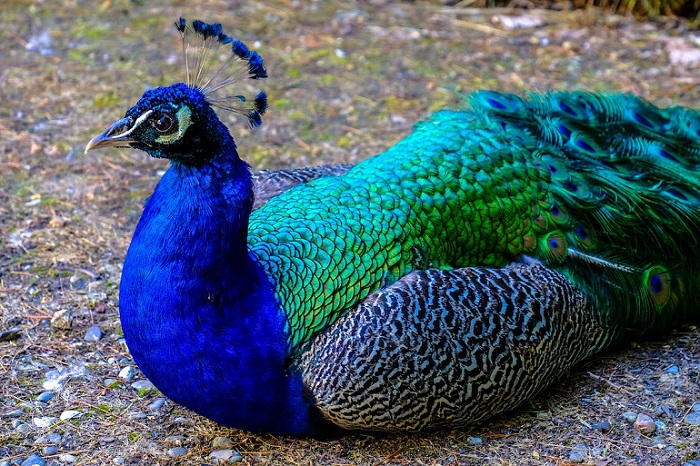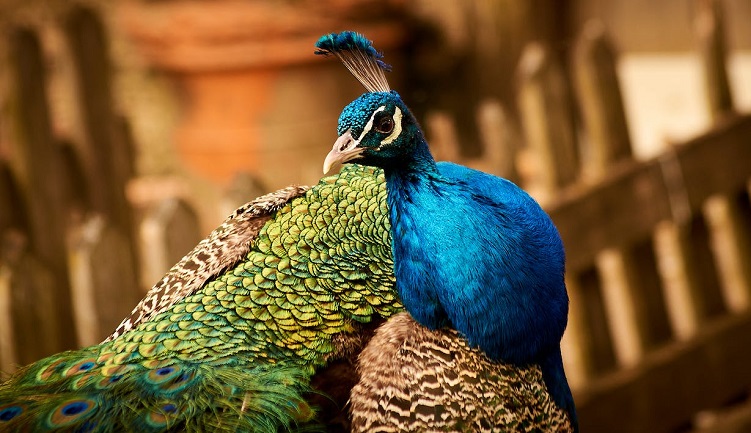Peacocks, renowned for their breathtaking iridescent plumage, are more than just beautiful birds. These captivating creatures, technically peafowl with males being peacocks, boast a rich history intertwined with mythology and royalty. This profile delves into the fascinating world of peacocks, exploring the different types, their preferred habitats, and intriguing facts about their behavior, diet, and conservation status. From the Indian Blue to the elusive Green Peafowl, discover the secrets of these majestic birds and the threats they face in a changing world.
If there’s one thing we all agree on, it’s the fact that peacocks are one of the most magical and majestic birds around.
Their huge train of distinctive feathers is a sight to see, and one you are unlikely to forget. Their train comes in a wide variety of different colors and patterns.
Whether you call them peafowl, peahens, or peacocks, these colorful pheasants are the national bird of India. Keep reading to find out more about these amazing birds.
Where Are Peacocks From
The two most common species of peacocks are – the Blue peacock which originates from India and Sri Lanka, and the Green Peacock, which comes from Java and Burma (Myanmar). The less familiar Congo species is native to the African rainforests.
What Is a Peafowl vs. Peacock?
Before we take a deep dive into peafowl and peacock, there’s a major piece of the puzzle that you need to know. And to be honest, most people aren’t even aware of it!
Peacocks are actually called Peafowl!
You normally find that all genders of this bird are called a peacock, but this is wrong unless you are referring to a male peafowl.
Peafowl is used for both peacocks and peahens (female peacocks!). This includes the three main breeds, the Indian Blue Peafowl, the Green Peafowl, and the Congo Peafowl.
There are a few different ways that you can tell the male and female apart. But the most obvious is their outrageously beautiful tail feathers!
Male peafowl has the large train of colorful feathers that most people think of when you mention a peacock. While the female peahen has muted beige or bronze tones to its feathers that are definitely not as bright as the males.
Types of Peacock
The three main types of peafowl have their own unique identifying colors, markings, and distinctive train.
Although there are now around 225 peafowl varieties that have evolved through selective breeding by species devotees, these three rule the roost.
Indian Peafowl (Pavo Cristatus)
Indian Peacock has feathers that are the most recognizable. They have bright blue heads and crests with brightly colored plumage that they use to attract peahens.
Also known as the Indian Blue Peafowl, they originate from the Indian subcontinent. They forage in small groups and very rarely fly unless in danger. This is due to the body length of the bird.
Green Peafowl (Pavo Muticus)
Native to Southeast Asia and endangered since 2009 due to the destruction of their habitat. Unlike other varieties, both sexes of this peafowl have similar blue and green colors.
These Green Peafowls have an impressive wingspan between 1.2m to 1.6m. Although typically, the female peafowl is almost half the size. They are considered to have one of the longest-length wingspans in the wild.
Congo Peafowl (Afropavo Congensis)
Finally, the Congo Peafowl is native to Africa and has a much more pheasant-like appearance with a blue and green sheen to them.
Congo Peafowl is classed as a vulnerable species. And sadly, this is due to the loss of their habitat.
Congo Peafowl’s diet mainly consists of fruit and insects.
Plumage
Peafowls are usually recognized for their vibrant plumage made up of metallic blue and green tones that spreads out across their tail/ train feathers. The edges of these feathers are recognized for their elaborate eyespots. Which is another characteristic that many people associate with them.
As we mentioned above, the three main species of peafowl are known for having different appearances and colors. But their plumage is the best way to recognize a species.
Plumage colors are also a great way to identify other aspects, such as the peafowl’s gender. The color of their feathers will also show if they are trying to ward off danger, or competition, or to protect their young.
Green Peacocks boast colorful green and gold clusters. They typically have blue or black wings, and this is the same for Green Peahens too. But the females will have a more coppery tone and less shine overall.
It’s rare to see the coverts on a Congo Peacock as they use their tail feathers during courtship displays. Even adult plumage, they have much shorter feathers, and the peahen is usually brown or grey.
Distinctive Tail Feathers
The plumage of an older peahen can change to mimic a male peacock, and their mating call can even change. These changes in plumage are caused by a lack of estrogen, usually caused by issues with their ovaries. This does mean that you can’t always rely on the peacock’s tail to determine their sex!
Aside from the amazing arrangement of colors, these tail feathers are a massively important part of the breeding season. Their iridescent tails are fanned out and put on display by males to attract a female hen for mating.
Their fan reaches the ground on either side of these animals, and the bigger and prettier they look, the more likely they are to find mates.
Natural History of Peacock
Beautiful and social, peafowls are one of the most popular birds to be domesticated. Although they have now been introduced all over the world, there is still a deep history and cultural background to these amazing animals.
They have an estimated population of between 10,000 and 100,000 birds globally.
“Phasianidae” is the scientific name of the Peacock. It comes from the pheasant family, and the history of their impressive large tails has caused a lot of debate.
Darwin believed they were used to attract females. But their large wingspan is also said to deter predators and assert dominance in situations with other males.
Their train is formed from the upper tail coverts, which are usually much longer when compared to the others. These are the feathers that feature an eyespot with blue and bronze rings.
When a male wants to display his feathers for a courtship display, they raise their tail located under the train. This brings vibrant colors forward and creates an impressive display.
Cultural Significance
The peafowl most commonly features in Hinduism. But it can be found woven right through Indian culture.
The peacock became the national bird of India in 1963 and is also one of their national symbols.
The Indian Blue Peafowl is famous for being the mount of the god of war.
It’s said during a war, a demon king was split in half, and the god converted the two halves into a part of himself. One became a rooster and the other a peacock.
You will also see peacock feathers on the crest of Lord Krishna. It is also a symbol of pride and vanity.
In Persia, the peacock is seen as a guardian of loyalty and is engraved upon royal thrones. The Ancient Greeks even saw the peafowl as a symbol of immortality.
While some early Christian paintings and mosaics show the peacock, with the eyes of their feathers seen as the all-seeing eye of God.
Where Is Peacock Indigenous To?
You can find peacocks worldwide as exotic pets or zoo attractions, but each species can be traced to a specific geographical area.
Indian Peacocks originate in the Indian Subcontinent, and the Green Peacocks in Southeast Asia. But the Congo Peacock is the only species native to Africa, specifically the Congo Basin.
During the latter half of the 20th century, the Green Peacock faced a steep decline in numbers due to overhunting. But there are now between 10,000 and 20,000 adults, but they are still classed as an endangered species.
Although you can now find peafowls all over the world, these are wild animals that should not really be kept as pets!
Peacocks Take Years to Develop Colorful Tail Feathers
When they hatch, peacock chicks will need a few years before they fully develop their colorful feathers. Many birds will need several molts before they can grow their long tail feathers.
Peacocks molt in late summer, and the process will take several months before they fully regrow. But this is a natural process needed to remove the old feathers and regrow their amazing new ones.
Just like a dog will shed old dead skin and fur, the peacock will lose feathers. But it can also be an indication of poor health, which is why they require specialized care.
Diet
Typically peacocks eat a huge variety of meat, fruit, veg, seeds, and more! Their diet in captivity will vary compared to how they survive in the wild. But they need a high-protein diet to maintain their gorgeous feathers.
In the wild, they can prey on small animals such as rodents and lizards to maintain their high protein requirements. But they’re fond of more exotic pickings too!
As a pet, they can survive on a grain or pellet diet with a mixture of extras such as fruits, seeds, vegetables, and even rodents!
Breeding
Peacocks and peahens mate the same way as any other bird and typically lay their fertilized eggs in the spring. But they have been known to lay them between February and August as well.
The hen will lay between 3 and 5 eggs and can take up to 10 days to lay all its eggs.
Eggs are laid in nests made of twigs and leaves. They incubate them here for a further month.
Once the babies hatch, they will remain in the nest for between 8 to 10 weeks. Then they will leave.
Peahens Are Picky When Choosing a Mate
Breeding fowl is not as straightforward as you may think. This is why there has been a huge conservation effort to try and increase their numbers.
Female peahens are very picky, and only those males with long bright feathers stand a chance!
The males must perform an elaborate display with their feathers. shaking them back and forth whilst making their mating call. This is all to woo the females into mating, but this isn’t always easy.
Females are known to reject males, so there are often several rejections before they choose “the one” to mate with!
Their Crests Are Important Sensors
There is far more to their gorgeous feathers than just showing off their appearance, breeding, or deterring predators. Their crests are also used as a way to give them a heightened sense of touch and detect pressure. This allows them to become more aware.
These sensors are used by the females to detect vibrations from their mates at a distance. This is another reason they can so easily reject a male’s attempts at mating.
As the males fan their tails, this creates a wave that the female’s crest can detect. This is also why they raise their crests to show aggression or anger as an early warning sign.
Conservation Status
Mating between peacocks and peahens is difficult, but it isn’t the only worry. Deforestation and habitat loss are causing the numbers of peafowl to drop dramatically.
The IUCN records the levels of known species and has a unique rating system in place. This is used to highlight any potential threats to survival or even overpopulation.
Sadly, the Green Peacock has had a huge decline in numbers. This is due to them being hunted for their feathers and even meat. These combined issues have meant their conservation status has dropped to threatened levels, and they could face further drops in the future.
Congo Peafowls are higher ranking and are classed as “near threatened” but not enough for major concern. The most popular Indian Blue peacock is of the least concern due to its protected nature through law and cultural beliefs in South Asia.
Gastronomy
The declining numbers of some peacock species could be due to their introduction as a delicacy dating back to 35 BCE.
There is an association between peacock meat and those of royal descent that makes the meal a delicacy in some cultures. But it has even had a history as the traditional nuptial feast of choice in some cultures.
Due to conservation and protection laws, the only species of peacock that can legally be slaughtered and consumed is the Blue Peafowl, as they are viewed as a delicacy by many.
FAQ’s
Can Peacocks Live in Cold Climates?
Although peafowls are native to warmer climates, they can be brought to colder climates. During colder weather, they will need shelter and protection as they do typically enjoy warmer climates more.
Can a peacock live in the wild?
The peacock is a wild bird by nature and can live happily in the wild, in their natural woodland or forest environments.
How Long Does a Peacock Live?
In the wild, peafowls are known to live anywhere between 10 and 15 years. Although in captivity, where their health can be easily monitored, they can live for up to 25 years.
How Long Does a Peacock Live?
Many people believe the peacock is known for dancing in the rain, but this is sadly a coincidence and not a Disney movie!
Peacock’s mating season clashes with the monsoons in India. So you often find them performing their mating rituals in these heavy rainy periods. This is why it may look like they are dancing in the rain!
Conclusion
These beautiful birds are deeply rooted in history as a mark of wealth, royalty, and beauty, and it’s easy to see why!
This gorgeous species is a popular pet for those with exotic tastes, but it’s not a choice you should make lightly. These birds need a lot of specialized care.
Peacocks, with their dazzling displays and iridescent plumage, are truly remarkable birds. From the vibrant Indian Blue to the rarer Green and Congo species, these pheasants captivate with their unique beauty and intriguing behaviors. While habitat loss threatens some populations, conservation efforts are crucial for preserving these stunning creatures. Understanding their diverse types, preferred environments, and fascinating facts contributes to appreciating the important role peacocks play in the biodiversity of our planet. Their continued existence ensures future generations can marvel at these living jewels.


